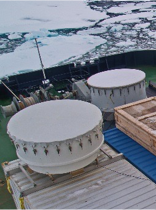Matthew Shupe
This data set includes retrievals of cloud type, characteristic particle size, and condensed water content for both liquid and ice hydrometeors. These retrievals are based on measurements from a millimeter cloud radar (MMCR), dual-channel microwave radiometer (MWR), ceilometer, and radiosondes. Clouds type classification are performed according to the Shupe (2007 GRL) method, ice properties are retrieved from radar reflectivity (Shupe et al. 2005 JAM), and liquid properties are derived using an adiabatic profile of liquid water from radar/ceilometer cloud boundaries and radiosonde temperature profiles. Liquid water concentration is constrained by the MWR-derived liquid water path.
Download data
Visit web site
Citation
Matthew Shupe (2018) Multi-sensor cloud microphysics product from the high-Arctic ASCOS expedition 2008. Dataset version 1. Bolin Centre Database. https://doi.org/10.17043/oden-ascos-2008-cloud-microphysics-1
References
Tjernström, M. et al. 2014. The Arctic Summer Cloud Ocean Study (ASCOS): overview and experimental design. Atmospheric Chemistry and Physics, 14, 2823–2869. https://doi.org/10.5194/acp-14-2823-2014
Data description
This data set includes retrievals of cloud type, characteristic particle size, and condensed water content for both liquid and ice hydrometeors. These retrievals are based on measurements from a millimeter cloud radar (MMCR0, dual-channel microwave radiometer (MWR), ceilometer, and radiosondes. Clouds type classification are performed according to the Shupe (2007 GRL) method, ice properties are retrieved from radar reflectivity (Shupe et al. 2005 JAM), and liquid properties are derived using an adiabatic profile of liquid water from radar/ceilometer cloud boundaries and radiosonde temperature profiles. The liquid is constrained by the MWR-derived liquid water path. All files are in netCDF format and thus contain data set and field-specific attributes in the files.
This is a large data set; you can alternately access the data via:
ftp://ftp1.esrl.noaa.gov/psd3/cruises/ASCOS_2008/ODEN/shupeturner/microp....
Comments
Information on clouds was also collected using surface-based remote sensing from two radars and one microwave radiometer. The main source of information comes from the MilliMeter Cloud Radar (MMCR) which is a vertically pointing Ka-band Doppler radar. The second radar is also a vertically pointing Doppler radar, but at the S-band. The MMCR, transmitting at 34 GHz, is very sensitive and ideal for probing low-level clouds, while the S-band radar is more adapted to measuring precipitation but can also be used for clouds.
Both radars provide three main user products for every measuring volume (determined by the increasing width of the radar beam and the height discrimination): The radar reflectivity; essentially the power of the backscatter of the radar beam; 2) The mean Doppler velocity; the mean vertical speed of all the hydrometeors with respect to the radar, and; 3) The width of the Doppler spectra; all hydrometeors within each volume does not have the same vertical velocity.
In addition to the radars a dual-wavelength radiometer was deployed, observing simultaneously the microwave radiation at two wavelengths, allowing the observation of the vertically integrated water vapor (PWV) and cloud liquid water (LWP).
By a combination of the information from the MMCR, the microwave radiometer, the cloud base ceilometer and the soundings, one can also estimate various cloud microphysics parameter can be estimated.
Original address: http://www.ascos.se/index.php?q=node/268
Files:
ascmicrobase1shupeturn.zip (26.38 MB)
Image caption
Photo of the cloud remote sensing instruments, showing the S-band radome in the back, the K-band MMCR on top of the radar container, containing all the electronics for both radars and the microwave radiometer at the bottom.
